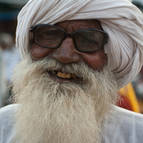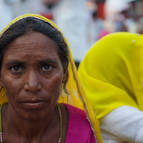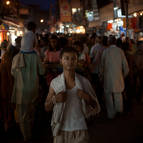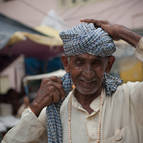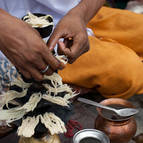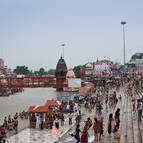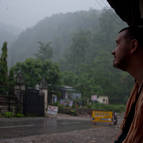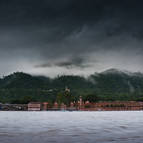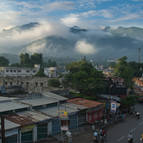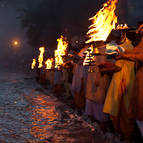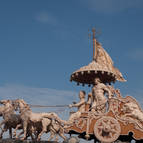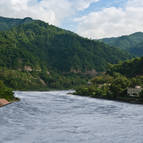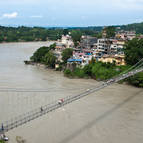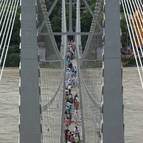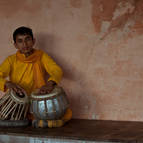What follows is a report by Gaura Gopala Dasa Brahmacari who went on a photographic journey in mid-August with B.V. Giri Maharaja to shoot images for our new Stock Photography website, Indica (www.indiastockphotography.com).
We emerged into the bright afternoon sun from the Delhi train station amidst the rickshaw stands and crowds of taxi drivers all vying for our attention. Straining under the weight of bags loaded with camera gear we went in search of cheap transportation to Haridwar. 30 minutes later we were in a small beat-up Indica car heading north. It was unseasonably hot and sunny and the broken A/C in the car did nothing to help alleviate the heat. On our way out of Delhi our driver stopped on the side of the road and walked away from the vehicle after assuring us he would be back soon. He returned a few minutes later carrying several bottles of alcohol and stowed them away in a hidden compartment in his trunk. Alcoholic drinks and non-vegetarian food are banned in many towns like Haridwar and Rishikesh so there is now a small black market for illegal substances in these places.
Despite driving at breakneck speeds and passing nearly every vehicle on the highway, it still took more than 5 hot and bumpy hours to reach Haridwar.
Haridwar is the point where the Ganges makes an exit from the Himalayan regions of the North and empties into the plains and flatlands of India. Haridwar is an ancient tirtha or holy place mentioned in many of the Puranas and the Mahabharata. Haridwar literally means “The Gateway of God”. Hari means God and more specifically to Vaisnavas it is another name of Visnu or Krsna. Dwara means “door” or “gateway”, thus the name “Haridwar”.
We arrived in Haridwar in the late evening as the sun was just touching the western horizon. Our arrival coincided with the last day of the Kanvar Mela. Haridwar is host to an annual festival known as the Kanvar Mela dedicated to Siva. The name comes from the sanskrit word “Kanvar” which is an instrument for carrying two water pots over the shoulder made from bamboo. Pilgrims devoted to Siva walk from their villages sometimes covering more than 100 kilometers on foot to attend the festival and bring Ganga water back on a “Kanvar” to their local Siva temples. This event takes place during the month of Sravana (July-August) according to the Vedic calendar. The festival has seen a sharp rise of attendance in recent years - this year (2010) being the largest attendance estimated at 1.15 crores (11,500,000 in western notation) over the course of 2 weeks.
We found a hotel room dropped off our excess bags and headed out with cameras in and to catch the last of the evening light and the Ganga aratik at the bathing ghats otherwise known as Hari-Ki-Paudi. This literally means “The steps of Visnu” because there is a large footprint said to have been made by Lord Visnu himself on a stone wall near the ghat. Hari-Ki-Paudi is the place where the evening aratik is offered to Ganga daily. A multitude of pilgrims and sadhus of every denomination gather for this ceremony and offer leaf cups filled with flowers and a burning wick. This event has taken place everyday since ancient times.
Over the next two days we spent our time taking shots of the pilgrims and sadhus of Haridwar as well as the labyrinthine marketplace.
The next day we found ourselves standing in what was apparently the Haridwar bus station as the rain began to come down – 500 square meters of open unpaved dirt with several huts at the back made of corrugated sheet metal. Due to the monsoon rainfall the buses were struggling through mud up to their axles until they exited the station back onto the paved roadway. Dodging mud and water kicked up by the buses we found one going the short distance to Rishikesh (about 25 kilometers) and started off into the foothills of the Himalayas. As we neared our destination the rain began to pour and run in small rivers down the sides of the roads.
The humidity levels in the valley of Rishikesh during the monsoon can be phenomenal causing the formation of dense fog banks above the icy temperatures of the Ganges. Low lying clouds and fog are constantly pouring over the valley’s ridges like liquid silk to add more moisture to the atmosphere. By the time we stepped off the bus in Rishikesh the rain had turned into a torrential downpour. Despite this we were greeted with a gaggle of rickshaw drivers fighting each other to reach us first, obviously desperate for some business. Following the directions of an outdated guidebook we got in a rickshaw and went in search of our hotel. We drove up the valley about 6km before continuing on foot. Unable to spot our hotel from the directions we obtained from our guidebook we began asking some of the locals sheltering from the rain in their shops and huts along the roadsides. Most people shook their heads at us or pointed farther up the road. We continued in this way for another 2km before reaching north edge of Rishikesh at a small police checkpoint. There were two policemen sitting under a tin roof drinking tea and stopping the occasional vehicle on it’s way to Badrinath in the north. We joined them under the meager shelter, happy to be out of the rain and asked them for the directions to our hotel. Both men gave us quizzical looks and then simultaneously pointed in opposite directions. As they argued over the directions in Hindi with each other we put our packs down and waited for the rain to subside. To cut a very long story short we found our hotel 3 hours later after crossing 2 bridges back and forth across the Ganga and taking a full tour of every aspect of the town - all the while calling the reception at the hotel and receiving conflicting directions at every turn. By the time we found our hotel we had walked approx 12km or more and seen most of Rishikesh. Despite being drenched and tired, we set out to shoot some photos of the valley in the sunless monsoon conditions.
Rishikesh (Hrsikesa) is one of the names of Visnu, meaning “Lord of the Senses”. Lord Visnu appeared to Raibhya Rsi after he performed tapasya (austerities). The valley itself is filled with yoga asramas, temples and hotels. Within the last 40 years it has become a frequented place for westerners and tourists who are seeking gurus, enlightenment and yoga. There are two bridges that span the valley gorge where the Ganges flows as well as numerous ghats. The bridges are named Laksmana Jhula and Rama Jhula after the Lord Rama and His brother Laksmana who performed penances here in the valley of Rishikesh. Originally these bridges were made with jute rope and wooden slats but in 1939 the British replaced them with steel suspension bridges.
Very quickly we realized that we needed our own transportation as traveling up and down the valley via rickshaw would prove to be expensive and impractical. So we found a reputable mechanic who rented out motorcycles. After this we had no trouble visiting the bathing ghats and asramas on both sides of the Ganges. Unfortunately the weather was continuously cloudy and raining until the last day of our stay - the sun came out and we seized the opportunity and spent the whole day taking photos.
All in all, despite a journey through some of the most humid locations in India during the monsoon season, we came away with some amazing shots and some great experiences.
